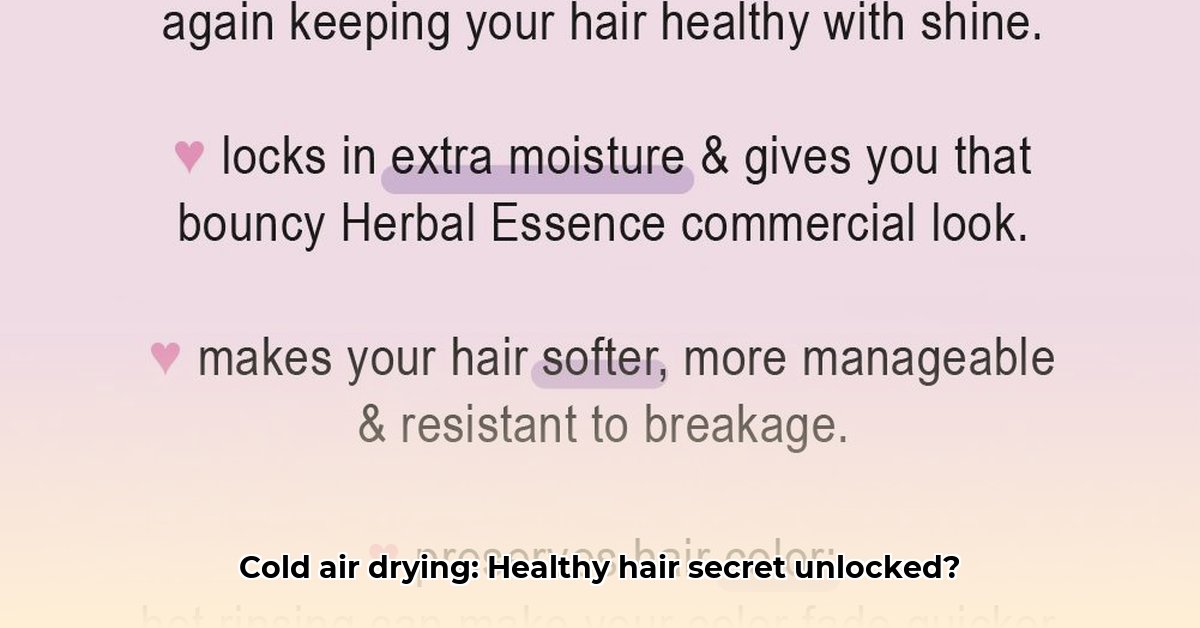
Benefits of Drying Hair with Cold Air
Switching from hot to cold air when blow-drying can significantly improve your hair's health and shine. Hot air can rough up the hair cuticle (the outermost layer of the hair shaft), leading to frizz, breakage, and dullness. Cold air, however, helps to smooth and seal the cuticle, resulting in a sleeker, shinier appearance. But what are the specifics? Let's dive in.
Understanding the Science Behind Cold Air Drying
Think of your hair's cuticle as tiny overlapping scales. Heat from a hairdryer can lift these scales, making your hair look frizzy and more prone to damage. Cold air helps these scales lie flat, creating a smoother, shinier surface. This is why cold air drying can lead to healthier-looking, more vibrant hair. Isn't that amazing? Did you know that this simple change can make a huge difference?
The Pros and Cons of Air Drying with Cool Air
While cold air drying offers many advantages, it's not without its drawbacks. Let's weigh the pros and cons to help you decide if it's right for you.
| Advantage | Disadvantage |
|---|---|
| Less heat damage: Minimizes heat-related damage, keeping hair healthier and stronger. | Longer drying time: Significantly longer than using hot air. |
| Vibrant color: Helps maintain hair color vibrancy by preventing heat fade. | Potential for over-drying (especially thick hair): Requires patience and proper technique. |
| Smoother, shinier hair: Creates a sleek, shiny finish by sealing the hair cuticle. | Less effective for some styles: May not provide the same lift or volume as heat styling. |
For many, especially those with thicker or longer hair, cold air alone might not be practical. However, incorporating a cold air finish into your routine can offer significant benefits.
Mastering the Cold Air Blow-Drying Technique: A Step-by-Step Guide
Ready to give cold air drying a try? Follow these steps for optimal results:
Prep Work: Start with damp hair. Gently squeeze out excess water with a microfiber towel; avoid harsh rubbing. This minimizes friction and speeds up the drying process.
Sectioning: Divide your hair into manageable sections. This ensures even drying and prevents missed spots, especially important for thicker or longer hair.
Warm-Up Round (Optional): For very thick or long hair, a brief warm-air blast initially can remove excess moisture, saving time. Then, switch to cold air to finish. What a time saver!
The Cold Air Finish: Once mostly dry, switch to cold air. Direct the airflow downwards, smoothing the cuticle and reducing frizz. Patience is key here – this is where the real magic happens!
Heat Protectant (Optional): A heat protectant spray can offer additional protection, even with cold air, guarding against environmental damage and maintaining moisture. This also improves the overall quality of hair.
Tips and Tricks for Success
Hair Type Considerations: Those with thick or long hair may need to combine warm and cold air for practical drying times. Experiment to find your ideal balance.
Dryer Quality: A good hair dryer with strong, even airflow is crucial. Investing in a quality dryer can significantly improve results.
Patience: Cold air drying takes longer. Embrace the slower process for the long-term health of your hair.
How to Prevent Cold Air Blow Drying Damage
While cold air is gentler than hot air, improper technique can still lead to damage. Let's explore how to avoid this. Isn't it crucial to know how to prevent damage even when using the cold air method?
Thorough Pre-Drying: Use a microfiber towel to gently remove excess water before blow-drying. This reduces drying time and minimizes the risk of over-wetting.
Strategic Sectioning: Divide hair into manageable sections for even airflow and to prevent some areas from staying damp too long.
Controlled Airflow: Direct cool air downwards, following the hair's natural growth pattern. Avoid harsh, concentrated blasts.
Maintain Distance: Keep the dryer a few inches from your hair to prevent over-drying and potential breakage.
Heat Protectant (Even with Cold Air): A heat protectant adds a layer of protection against environmental stress and moisture imbalance.
Monitor Dampness: Regularly check for dampness. Cold air drying can still cause brittleness if hair remains soaking wet for too long.
Finish with Cold Air: Use a final cold shot to seal the cuticle and add shine.
Air Dry Completely: Once mostly dry, allow your hair to air dry fully to avoid over-drying.
Refining Your Routine: Long-Term Strategies
- Experiment: Find what works best for your specific hair type and length.
- Invest Wisely: A high-quality hair dryer enhances the cold air drying process.
- Professional Consultation: Seek advice from a hairstylist for personalized recommendations.
By following these steps and tips, you can harness the many benefits of cold air drying while minimizing potential damage, achieving healthier, shinier hair. Remember, patience and proper technique are key.